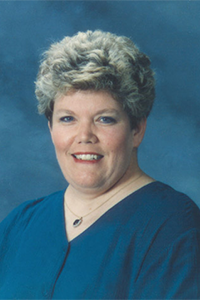Mending the Family Circle
Author: Darcie Sims
Coping with the Death of a Loved One
Once I lived the American Dream. We were a happy family, military by career and parents by choice. And with the birth of our son, our family was to have been complete…whole…two kids so no one would have to fight over a window in the back seat, two kids because I had a lot of recipes that served four. We called him Big A and he had a big sister named Allie. We were the American Dream, at least for a little while.

And then, as it has happened to countless other families, we learned you couldn't paint a rainbow on a wall and expect it to stay. Big A died after a long battle with a malignant brain tumor. The dream came to pieces and we were shattered. No longer the American Dream, we became the American Nightmare. We were bereaved.
We entered a world we knew nothing about. We were strangers in a strange world. We needed help. We needed support. We needed someone who could speak our language, the language of grief. We stumbled into a darkness that seemed endless and we became lost in despair. We were grieving, but we didn't know how.
Others thought they knew what we should do, but no one really wanted to talk with us. So we stumbled along in the Valley of the Shadow of Death, grieving not just the death of our child, but the loss of friendships, self-esteem, and self-identity as well.
We learned that grief is a natural and normal reaction to loss. It is a physical, emotional, psychological, and spiritual response. It is a complex process, guided by our past experiences, religious beliefs, socio-economic situations, physical health, and the circumstances of the loss. Love, anger, fear, frustration, loneliness, depression, and guilt are all a part of grief. It is important to understand, however, that grief is not a sign of weakness or a lack of faith; grief is the price we pay for love.
Grief is adapting, changing, discarding, trying on, taking off. It's a dance and just as we learn the steps, the music changes and we begin again and again and again. We discovered that grief takes far longer than anyone expects, but grief is a dynamic process, a living process with many ups and downs, peaks and valleys, stops and starts.
Grief is being numb, in shock, frozen, protected by a physiological fog that keeps the pain and intensity of reality from our minds, at first. Grief is hurt, raw physical hurt, as well as psychological, spiritual, and emotional pain. It is a terrible physical internal injury that no one sees, because we learn, early on, to hide behind the “I’m fine” mask that society demands we wear.
Grief is being angry, feeling guilty for everything, being frustrated, and feeling helpless. We live with the jagged pieces of a broken heart, not quite sure it will ever mend or that we will ever live beyond today. But we do and somehow, we struggle through the depression, the loneliness, and the fear.
We discovered that each of us grieves alone, but that you do not have to be alone in your grief. We also learned, and are still learning, that there are no time frames for grief. Each will grieve in his own way, in her own time frame. Grief may seem endless, yet it is a journey, with many stops and starts.
Grief changes as the seasons do, but grief isn’t a seasonal song. It’s a lifetime song, but it doesn't have to be a sad song forever.
We can heal from the terrible hurts of grief, but only if we allow ourselves to claim every hurt and learn to live through them, not avoid them. There are no short cuts to grief. No one can make the hurt any less. But there are things you can do to help yourself and support those who are hurting so deeply.
A FEW SIMPLE STEPS TOWARDS HEALING
- Acknowledge the loss.
- Embrace and own the experience and the loss—whatever you are feeling.
- Allow yourself to experience all the emotions of grief.
- Find ways to express your anger and pain in non-destructive actions.
- Find supports. Build a support system of compassionate listeners.
- Skip the self-judgment. Let the judgment of others pass through you without damage.
- Forgive yourself for whatever you believe you have done or not done.
- Work toward healing.
- Practice forgiving yourself for living.
- Concentrate on your loved one’s life, not the death.
- Discover the person you are now.
- Begin to release the hurt in search of hope.
- Release the anger and the guilt. Be careful what you release. Once released, you cannot have that hurt, anger or guilt again.
- Never, ever, ever forget your loved one lived.
MAY LOVE BE WHAT YOU REMEMBER THE MOST
Our loved ones died. We did not lose them or the love we shared. Our loved ones are still and always will be a part of us. We cannot lose that love. I will learn to weave my grief into the tapestry of my life, but I will never say good-bye or stop loving Big A.
Come with me on my journey through grief. You cannot eliminate the pain of death, but you can ease the loneliness, confusion, and despair. Come with me and know that we are all a family circle, broken by death, but mended by love.
 By Darcie D. Sims, PhD, CHT, CT, GMS: Dr. Darcie Sims is a bereaved parent and child, nationally certified thanatologist, certified pastoral bereavement specialist, and licensed psychotherapist and hypnotherapist. She is the president and cofounder of Grief, Inc., a grief consulting business, and the Director of the American Grief Academy in Seattle, Washington. Darcie is an internationally recognized speaker and writer, having authored seven books and numerous articles. She currently serves as the Director of Training and Certification for TAPS. For more information and a complete listing of her books, visit www.griefinc.com.
By Darcie D. Sims, PhD, CHT, CT, GMS: Dr. Darcie Sims is a bereaved parent and child, nationally certified thanatologist, certified pastoral bereavement specialist, and licensed psychotherapist and hypnotherapist. She is the president and cofounder of Grief, Inc., a grief consulting business, and the Director of the American Grief Academy in Seattle, Washington. Darcie is an internationally recognized speaker and writer, having authored seven books and numerous articles. She currently serves as the Director of Training and Certification for TAPS. For more information and a complete listing of her books, visit www.griefinc.com.
